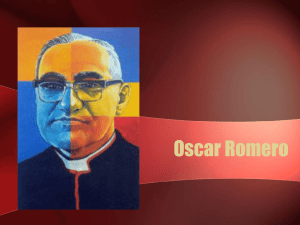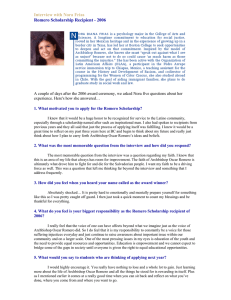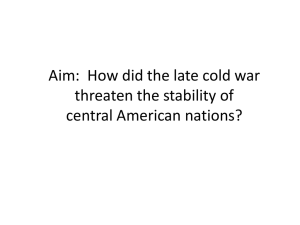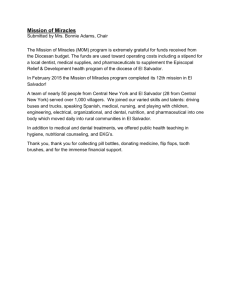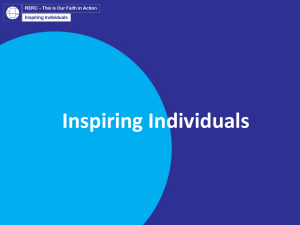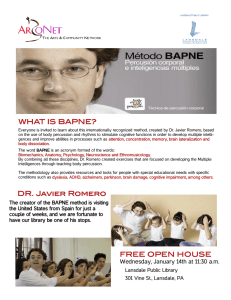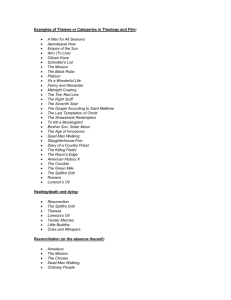Why El Salvador? - Day 1
advertisement
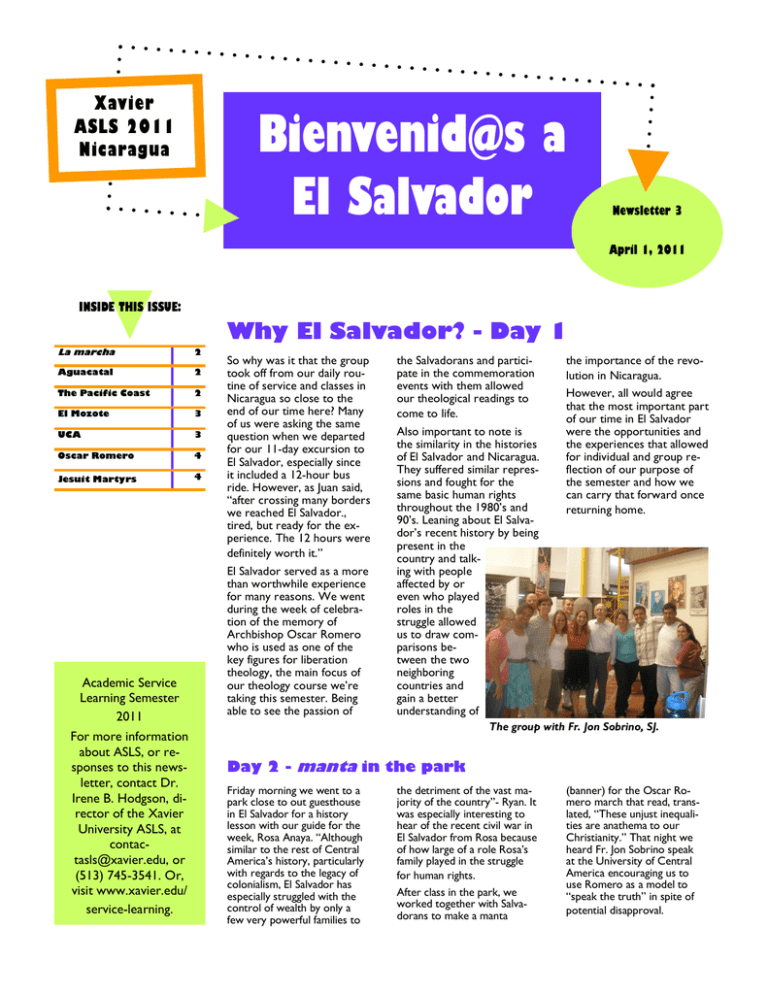
Xavier ASLS 2011 Nicaragua Bienvenid@s a El Salvador Newsletter 3 April 1, 2011 INSIDE THIS ISSUE: Why El Salvador? - Day 1 La marcha 2 Aguacatal 2 The Pacific Coast 2 El Mozote 3 UCA 3 Oscar Romero 4 Jesuit Martyrs 4 Academic Service Learning Semester 2011 For more information about ASLS, or responses to this newsletter, contact Dr. Irene B. Hodgson, director of the Xavier University ASLS, at contactasls@xavier.edu, or (513) 745-3541. Or, visit www.xavier.edu/ service-learning. So why was it that the group took off from our daily routine of service and classes in Nicaragua so close to the end of our time here? Many of us were asking the same question when we departed for our 11-day excursion to El Salvador, especially since it included a 12-hour bus ride. However, as Juan said, ―after crossing many borders we reached El Salvador., tired, but ready for the experience. The 12 hours were definitely worth it.‖ El Salvador served as a more than worthwhile experience for many reasons. We went during the week of celebration of the memory of Archbishop Oscar Romero who is used as one of the key figures for liberation theology, the main focus of our theology course we’re taking this semester. Being able to see the passion of the Salvadorans and participate in the commemoration events with them allowed our theological readings to come to life. Also important to note is the similarity in the histories of El Salvador and Nicaragua. They suffered similar repressions and fought for the same basic human rights throughout the 1980’s and 90’s. Leaning about El Salvador’s recent history by being present in the country and talking with people affected by or even who played roles in the struggle allowed us to draw comparisons between the two neighboring countries and gain a better understanding of the importance of the revolution in Nicaragua. However, all would agree that the most important part of our time in El Salvador were the opportunities and the experiences that allowed for individual and group reflection of our purpose of the semester and how we can carry that forward once returning home. The group with Fr. Jon Sobrino, SJ. Day 2 - manta in the park Friday morning we went to a park close to out guesthouse in El Salvador for a history lesson with our guide for the week, Rosa Anaya. ―Although similar to the rest of Central America’s history, particularly with regards to the legacy of colonialism, El Salvador has especially struggled with the control of wealth by only a few very powerful families to the detriment of the vast majority of the country‖- Ryan. It was especially interesting to hear of the recent civil war in El Salvador from Rosa because of how large of a role Rosa’s family played in the struggle for human rights. After class in the park, we worked together with Salvadorans to make a manta (banner) for the Oscar Romero march that read, translated, ―These unjust inequalities are anathema to our Christianity.‖ That night we heard Fr. Jon Sobrino speak at the University of Central America encouraging us to use Romero as a model to ―speak the truth‖ in spite of potential disapproval. Day 3 - Pro-Búsqueda and la marcha Saturday morning we had the incredible opportunity to meet with two representatives of Pro-Búsqueda, a group committed to helping locate the biological families of the children separated from there’s during the war as they shared their person accounts of losing contact with their families. ―Getting such a personal account on such a strong historical concept can never be forgotten. I could never imagine the trauma they endured and continue to recall as they must go on with their lives providing for their families, but I’m glad we were there to hear the story and take away a little of the weight by listening,‖ said Brooke. No book or historical documents can rival their raw, first-hand accounts of the kind of pain the war brought to countless families. It was an honor for all of us to meet them and share in the pain of their stories. Saturday night was the march in memory Archbishop Oscar Romero and the continuation of the struggle for human rights which was about two miles leading to the Cathedral where there was an all night vigil in his honor. It was an eyeopening event marching with so many people in solidarity and passionate commitment to the same issues. The power and strength of the people was definitely a palpable force that night. As we marched we chanted ―Romero vive; la lucha sigue‖ meaning that Romero lives and the fight continues. Day 4-6 - Welcome to Aguacatal We were blessed with the was extremely welcoming opportunity to visit the and accompanied us on many campo. We stayed two and a adventures: hiking down to la half days in the community of quebrada (the brook), hiding Aguacatal in the department ―The people in Aguacatal had a beautiful of Morazán. innocence from globalization, while at We all buddied the same time they were very aware of up and spent their violent history. I have never the night with experienced more hospitality and families there. eagerness to share stories.‖ - Eva Marie The community in a cave like the guerrillas, visiting El Mozote and the museum at Perquín, swimming and bathing in the Río Sapo, and dancing the night away. One of the families even offered Zeke a chicken because he was trying to catch them all weekend. Day 7 - fun in the sun Wednesday we were supposed to visit the Legislative Assembly. However, President Obama decided to visit the country, which naturally meant all government employees got a two-day vacation. With the change of plans the group spent the morning reflecting with a man named Juan Carlos Hernández. After lunch we got to visit the beach. El Salvador’s Pacific Coast Page 2 had the biggest waves any of us have ever seen. Though it was hard work constantly fighting the water, it was nice for all of us to have a day without commitments and time to relax. Carlos right after we got back from Aguacatal. The atmosphere was very reflective, which I think allowed all of us to absorb our powerful experience in the campo.‖ Anna ―We talked with Juan BIENVENID@S A EL SA LVA DOR Page 3 NEWSLETTER 3 A Brief History of El Mozote Though the extent of the violence in the massacre at El Mozote is often denied, there is no way to avoid the realization that ―El Mozote may well have been the largest massacre in modern Latin American history,‖ (Mark Danner) in which close to 1000 people were killed. During the civil war in the 1980’s, anyone suspected of having been infected with the ―cancer of communism,‖ and even innocent civilians were killed in order to sustain the reign of terror and oppression of the people. The massacre at El Mozote that occurred in 1981 is a perfectly horrifying exemplification of this terrorizing tactic. El Mozote was a peaceful indigenous village in the mountains of El Salvador. Throughout the civil war, the people abstained from voicing opinions or providing support to the guerillas, not wanting to have any reason for questioning from the Atlacatl Special Forces. However, their proximity to the guerilla fighting proved to be enough to endanger them and take the lives or all but a handful of civilians, including women and children. The people of El Mozote were taken out of their homes and brutally murdered by the Special Forces on December 1, 1981. Before being killed, the women were separated from the men of the and forced to sit huddled in a small house listening to the men filing out of the houses and into the church to be shot. Next came the women, and finally the Day 8 - Central American University children, many of whom were thrown into the air and bayoneted. The US denied involvement with the atrocious massacre for a long time, but over the years more information has leaked out as to the government’s support of the Special Forces. The fear of communism allowed for the death of an entire community. The group in the Garden of Children, built where the church of El Mozote once stood. Thursday, March 24 was the dencia, where Archbishop 31st anniversary of the death Romero was killed. We then of Archbishop Oscar Romoved on to the National mero. We Cathedral to visit started the Romero’s tomb. ―Romero is truly a morning by atHundreds of peouniversal figure; one tending Mass ple were there does not have to have a paying their reand visiting the Christian background to museum at the spects and prayidentify with his story.‖ ing for miracles in cancer hospital - Zeke Divina Provihis name. Many people already consider him as Saint Romero of the Americas. We then visited the Central American University (UCA) and the site where the six Jesuit martyrs, their housekeeper, and her daughter were killed in 1989. There is now a museum and a beautiful rose garden in their memory. Day 9-10 - Talk of Truth and Justice Our last 2 days in El Salvador provided us with further opportunities to witness the continuing struggle for truth and justice. Friday we went to SSPas, an organization dedicated to the education and prevention of violence in San Salvador to discuss what initiatives are being taken to ensure the continuation of development of human rights. That afternoon we met with Mirna Perla. ―What an amazing experience to sit with the first female supreme court justice in El Salvador and have a frank conversation!‖-Liza. These 2 meetings allowed us to see the light of hope amidst the disheartening struggle. Saturday morning we were blessed by being able to participate in a traditional Mayan ritual giving thanks to the Creator for life. The spirit of the people of the community was evident. Later that night, we all had a great time at La Festival de la Verdad (Festival of Truth) at the UCA during which there was an ongoing concert of bands singing about human dignity, importance of the youth and hope for the future. The number of young people singing along about striving for a better tomorrow was encouraging and inspirational. There really is a great deal of potential and hope in the youth of Central America. It helps, now and then, to step back and take the long view. The kingdom is not only beyond our efforts, it is even beyond our vision. We accomplish in our lifetime only a tiny fraction of the magnificent enterprise that is the Lord’s work. Nothing we do is complete, which is another way of saying that the kingdom always lies beyond us. No statement says all that should be said. No prayer fully expresses our faith. No confession brings perfection, no pastoral visit brings wholeness. No program accomplishes the church’s mission. No set of goals and objectives includes everything. This is what we are about. We plant seeds that one day will grow. We water seeds already planted, in knowing that they hold future promise. We lay foundations that will need further development. We provide yeast that produces effects far beyond our capabilities. We cannot do everything and there is a sense of liberation in realizing that. The enables us to do something and to do it very well. It may be incomplete, but it is a beginning, a step along the way, an opportunity for the Lord’s Grace to enter and do the rest. We may never see the end results, but that is the difference between the master builder and the worker. We are workers, not master builders, ministers, not messiahs. We are prophets of a future that is not our own. Monseñor Oscar Romero Monseñor Oscar Arnulfo Romero was selected to be the archbishop of San Salvador, El Savador in 1977. The country was in an epoch of great repression from the government. Peasants were denied their right to vote, and when they met to protest rising food prices and unlivable wages they were met with violence. Romero was selected for this position because everyone believed his moderate ideology and quiet demeanor would not cause problems for the repressive government. After the assassination of his good friend Fr. Rutilio Grande, SJ, though, he began to speak out against the injustices of the Salvadoran situation. He rejected government bribes of vacation homes and lived in a humble hospital community. All of Romero’s homilies were broadcast over the radio, and he openly opposed the violence of the repression and begged the military to stop killing their brothers and sisters. While saying a private Mass in the hospital chapel, Oscar Romero accepted his fate as a martyr for the Salvadoran people. An audio recording of the Mass tells us that his voice didn’t even quiver. Romero’s prayer has been granted, though: he has indeed been resurrected in the Salvadoran people. <—- A prayer popularly attributed to Archbishop Romero The Jesuit Martyrs In 1989, during the civil war in El Salvador, the National Guard launched its final offensive against the capital city of San Salvador. The Jesuit–run Central American University was considered a safe-haven. For this reason, Julia Elba Ramos, the housekeeper for the Jesuits, and her daughter Celia Ramos stayed in the Jesuit residence to be safe on the night of November 15. Little did they know that the Jesuits were targeted by the National Guard. Ignacio Ellacuría, Ignacio Martín-Baró, Segundo Montes, Armando López, Joaquín López y López, and Juan Ramon Moreno were educators at the university who sought to instill in their students a sense of This newsletter has been brought to you by: Abby Anderson and Kayla Neal justice and solidarity. They encouraged their students to question the government’s repression and fight for the rights of the Salvadoran people. In the middle of the night the six Jesuit priests were dragged from their beds into the yard, where they were tortured and assassinated. Julia Elba and Celia were also killed for witnessing it all. Although the members of the Atlacatl Battalion (who were trained by the Green Berets the week before) who were responsible for their murders were identified, they have not been brought to justice. Translated: If they kill me, I will rise again in the Salvadoran people.
